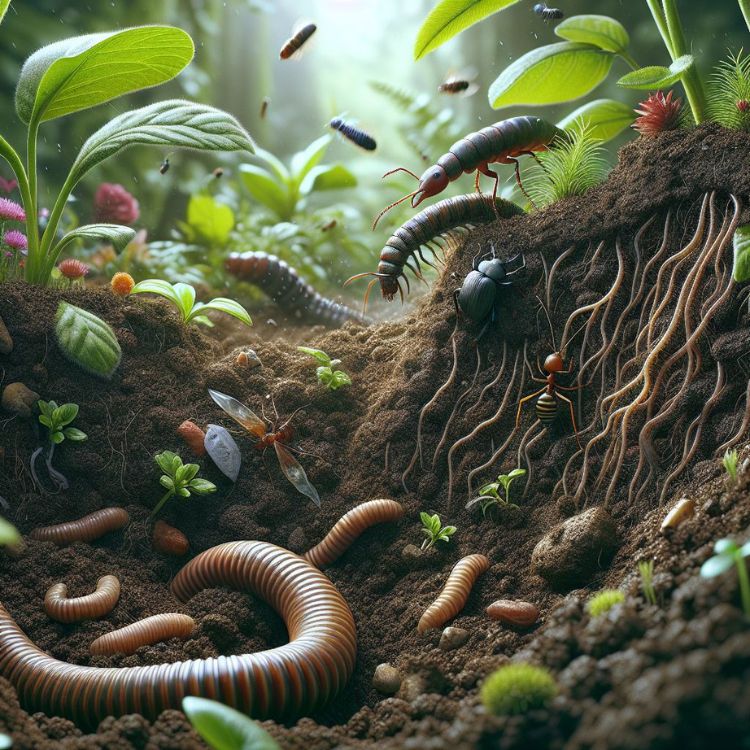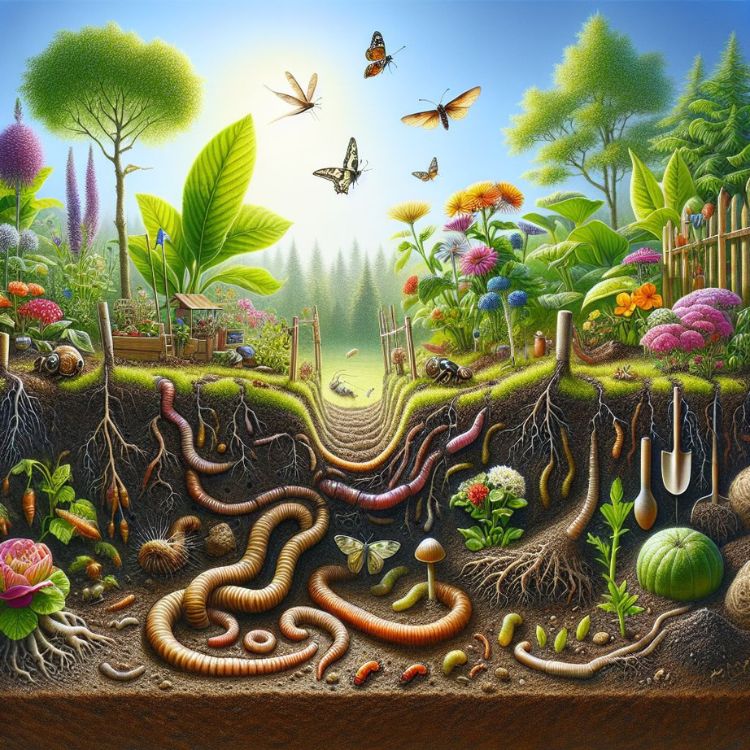
Key Takeaways
- Introducing earthworms and beneficial insects into your garden can significantly improve soil health.
- Earthworms enhance soil structure, increase nutrient availability, and aid in plant growth.
- Beneficial insects can naturally control pests and reduce the need for chemical interventions.
- Creating a garden environment that supports these creatures involves simple steps like organic matter addition and avoiding pesticides.
- Investing in the right types of earthworms and plants can attract beneficial insects, leading to a more productive and sustainable garden.
Why Your Garden Needs Insects and Worms
Imagine your garden as a bustling city where every inhabitant plays a crucial role in keeping the community thriving. That’s exactly what insects and worms do for your soil. They’re the unsung heroes that work tirelessly beneath the surface, ensuring your plants have everything they need to grow strong and healthy.
The Dynamic Duo: Earthworms and Beneficial Insects
Why focus on earthworms and insects? Well, earthworms are like the architects of your soil structure. They burrow and create tunnels, which allows air and water to reach plant roots more effectively. On the other hand, beneficial insects act as the garden’s defense system against harmful pests, reducing the need for chemical pesticides.
Healthy Soil, Healthy Harvest: The Link Explained
There’s a simple truth in gardening: the healthier your soil, the healthier your plants. A vibrant, living soil teeming with earthworms and beneficial insects is the foundation of a bountiful garden. These creatures break down organic matter, recycle nutrients, and help maintain a balanced ecosystem, leading to a more resilient and productive garden.
Identifying Allies in the Soil
Before we invite these allies into our gardens, we need to know who they are. Earthworms and beneficial insects come in various shapes and sizes, each with unique contributions to soil health and plant protection.
Meet the Soil Savers: Common Beneficial Insects
Ladybugs, bees, lacewings, and hoverflies – these are just a few of the beneficial insects that can make a home in your garden. They pollinate plants, decompose organic material, and prey on pests like aphids and mites. By recognizing these allies, you can tailor your garden to be a welcoming habitat for them.
Digging Deeper: The Various Earthworm Species
Not all earthworms are created equal. Red wigglers, nightcrawlers, and garden worms each have their specialty. Red wigglers are composting champions, breaking down kitchen scraps and garden waste into rich humus. Nightcrawlers, on the other hand, are deep burrowers, aerating the soil as they go. Knowing which species benefits your garden the most is key to cultivating a healthy soil ecosystem.
- Red Wigglers: Best for composting and topsoil enrichment.
- Nightcrawlers: Ideal for soil aeration and deep nutrient cycling.
- Garden Worms: Great all-rounders for general soil health improvement.
DIY Worm Bins: Bringing Composters Home
Setting up a DIY worm bin is like opening a tiny recycling plant right in your backyard. It’s easier than you might think, and the benefits are enormous. Start with a container – something as simple as a plastic tote will do. Drill some holes for aeration, fill it with bedding like shredded newspaper or leaves, add some kitchen scraps, and introduce your red wigglers. In no time, they’ll start turning waste into black gold for your garden.
Remember, balance is key. Your worms will thrive on a mix of greens, like vegetable peels, and browns, such as cardboard. Keep the bin in a spot that’s cool and shaded to avoid overheating, and make sure the bedding stays moist but not soggy. With just a little care, your worm bin will be a low-maintenance, high-reward system that supports your garden’s ecosystem.
Direct Impact: Benefits of Insect and Worm Integration

The introduction of earthworms and beneficial insects to your garden is a game-changer. These tiny workers play a massive role in the health and productivity of your soil. They not only improve the physical structure of the soil but also increase its fertility, leading to stronger, more resilient plants.
Most importantly, integrating insects and worms into your garden creates a sustainable, self-regulating environment. This means less work for you in the long run, as these creatures help manage waste and control pests naturally. It’s a win-win for you and the environment.
From Waste to Wealth: The Miracle of Worm Castings
Worm castings, the end product of the breakdown of organic materials by earthworms, are a miracle for gardeners. Often referred to as ‘black gold’, these castings are packed with nutrients that are easily absorbed by plants. They contain more nitrogen, phosphorus, and potassium than average garden soil – all essential for plant growth.
By using worm castings, you’re giving your plants a concentrated dose of the good stuff, without the risk of chemical fertilizers. Plus, castings help improve soil structure and water retention, making your garden more drought-resistant.
Pest Patrol: How Insects Keep Balance in Your Garden
Insects are nature’s pest control agents. Ladybugs munch on aphids, spiders catch pesky insects in their webs, and parasitic wasps lay their eggs inside harmful pests. By welcoming these beneficial insects into your garden, you’re setting up a defense system that works day and night to protect your plants.
Encourage these helpful critters by planting a variety of flowers and herbs. They’ll be attracted to the blooms, and in return, they’ll keep an eye on your veggies. It’s a beautiful partnership that keeps your garden healthy and balanced.
Example: Marigolds are not just pretty; they’re a powerhouse in the garden. Plant them around your vegetable patch to attract ladybugs and other beneficial insects, and watch as they deter nematodes and other pests that could harm your plants.
By using companion planting strategies, you’re not just beautifying your space – you’re building an ecosystem that works together for the greater good of your garden.
Soil Structure and Fertility: Earthworms at Work
When earthworms move through the soil, they’re doing more than just wriggling around. They’re engineers, creating tunnels that help water and air penetrate the soil, which is vital for root development. Their movement also helps to mix the soil layers, improving the distribution of nutrients and beneficial microorganisms.
Maintaining Balanced Biodiversity
Biodiversity is the spice of life, even in the soil. A diverse population of insects and worms means a healthier, more stable garden ecosystem. This diversity helps to ensure that no single pest or disease can easily take hold and cause widespread damage.
Fostering an Ecosystem: Long-term Strategies
To maintain a balanced biodiversity in your garden, it’s crucial to think long-term. Start by planting a variety of species that bloom at different times of the year, providing a constant food source for beneficial insects. Avoid using broad-spectrum pesticides, which can harm the very creatures you’re trying to encourage.
Compost and mulch are your best friends. They not only nourish the soil but also provide habitats for insects and worms. A healthy garden is a self-sustaining one, where each creature plays a part in the cycle of life.
Monitoring and Managing Population Dynamics
Keep an eye on your garden’s inhabitants. If you notice an imbalance, such as an overabundance of a particular insect, it might be time to intervene. Introducing natural predators or adjusting your planting strategy can help restore balance without resorting to chemicals.
Remember, a little observation goes a long way. Regularly inspect your plants and soil, and you’ll be able to spot issues before they become serious problems.
Troubleshooting Common Issues
Even with the best planning, issues can arise. It’s all part of the gardening journey. The key is to address problems early and with a focus on sustainability.
When Good Bugs Go Bad: Managing Overpopulation
Sometimes, even beneficial insects can become too much of a good thing. If ladybugs or bees become too numerous, they might start to stress your plants. You can gently relocate some of these insects to other areas of your garden or share them with fellow gardeners. For more information on managing your garden’s ecosystem, check out these safe and effective solutions for survival garden pest control.
Too Much of a Good Thing: Earthworm Overabundance
While earthworms are generally beneficial, an overabundance can lead to issues like nutrient leaching or root disturbance. If you find your garden has too many worms, consider harvesting some to start a new compost bin or sharing them with others.
Real-World Success Stories
Real gardeners have seen remarkable transformations by integrating earthworms and beneficial insects into their practices. These success stories serve as inspiration and proof that sustainable gardening isn’t just a concept; it’s a reality.
Case Study: A Garden Revived by Earthworms
Take Sarah’s garden, for example. After introducing red wigglers, she noticed her plants were more robust and her vegetables more plentiful. The worms had revitalized her soil, making it more fertile and better structured for root growth.
Before and After: Insect Integration Transformation
Then there’s James, whose rose garden was once plagued by aphids. By attracting ladybugs and releasing lacewings, he saw a dramatic decrease in aphid populations, and his roses flourished like never before. It’s clear that with a little knowledge and effort, anyone can create a thriving, sustainable garden.
As we continue to delve into the world of sustainable gardening, it’s important to understand the transformative power of integrating insects and worms into our garden’s ecosystem. The symbiotic relationship between these creatures and our plants is the cornerstone of a flourishing garden.
Before and After: Insect Integration Transformation
Let me paint you a picture: John’s garden, once a battleground against pests, is now a thriving hub of productivity. By introducing beneficial insects like ladybugs and praying mantises, he’s seen a significant decrease in the damage caused by aphids and other harmful insects. The balance restored, his garden is not only surviving but thriving.
Then there’s Linda’s story. Her soil was compacted and lifeless, but with the introduction of earthworms, it’s now loose, rich, and full of life. Her plants are healthier, and her harvests are more bountiful. It’s clear that the right kind of attention to soil health can lead to dramatic improvements in the garden.
Boost Your Garden’s Ecosystem Today

Now, let’s turn our attention to how you can boost your garden’s ecosystem. It all starts with understanding what your garden needs and then taking action to provide a habitat that supports the growth of both earthworms and beneficial insects.
Start with simple steps like reducing chemical usage, adding organic matter to your soil, and planting a variety of species to encourage biodiversity. These practices not only improve your garden’s health but also make it a more inviting place for these helpful creatures.
For example, by simply adding a layer of mulch to your garden beds, you can conserve moisture, suppress weeds, and provide a habitat for earthworms to thrive.
And remember, the best time to start is now. With each season, you can build upon your garden’s health, creating a more robust and self-sustaining ecosystem.
Top Products to Get Started With Insect and Worm Integration
When it comes to getting started, there are a few key products that can help you on your journey to a healthier garden:
- Composting bins or worm farms for on-site organic waste recycling.
- A variety of heirloom seeds to promote a diverse ecosystem and attract different beneficial insects.
- Organic mulches, such as straw or wood chips, to protect and nourish the soil.
Investing in these tools not only supports your garden’s immediate needs but also contributes to its long-term sustainability.
Ensuring a Year-Round Healthy Soil Structure
A healthy soil structure doesn’t happen overnight. It’s the result of consistent care and the integration of organic practices throughout the year. This includes rotating crops, adding compost regularly, and allowing areas of your garden to rest and rejuvenate.
By planning your garden activities with the health of your soil in mind, you’ll ensure that your garden remains productive and vibrant, no matter the season.
Where to Find Quality Composting Worms and Beneficial Insects
If you’re looking to introduce composting worms or beneficial insects into your garden, you’ll want to source them from reputable suppliers. Online stores like Survival Essentials offer a variety of products to get you started. Their collection includes live worms and heirloom seeds, which can be found at Survival Essentials. For more information on creating healthy garden soils with the help of insects and worms, consider exploring additional resources.
Frequently Asked Questions
It’s natural to have questions as you embark on this journey. Let’s address some of the most common inquiries gardeners have about soil health and the role of earthworms and insects.
Can any insect be beneficial to my garden’s soil?
Not all insects are beneficial for your garden. It’s important to distinguish between those that will aid your garden’s growth and those that may cause harm. Beneficial insects typically fall into two categories: pollinators, like bees and butterflies, and predators, like ladybugs and lacewings, which control pest populations.
How do I know if I have enough earthworms in my soil?
A simple way to gauge if you have a healthy earthworm population is to dig a square foot of soil about 6 inches deep and count the number of earthworms you find. Generally, 5-10 earthworms indicate a healthy soil. However, this can vary depending on soil conditions and time of year.
What are the signs of an unhealthy soil ecosystem?
Signs of an unhealthy soil ecosystem include poor plant growth, a hard soil surface, water pooling instead of infiltrating, and a lack of visible earthworms or beneficial insects. If you notice these signs, it’s time to take action to improve your soil health.
Are there any risks to introducing non-native worms to my garden?
Introducing non-native worms can disrupt local ecosystems. It’s best to work with species that are native to your area or that have been proven to integrate well without causing harm. Always research or consult with a specialist before introducing new species to your garden.
How can I attract more beneficial insects to my garden?
To attract beneficial insects, plant a variety of flowering plants that bloom at different times throughout the growing season. This provides a continuous food source for these insects. Additionally, avoid using pesticides, as they can harm the beneficial insects you’re trying to attract.






